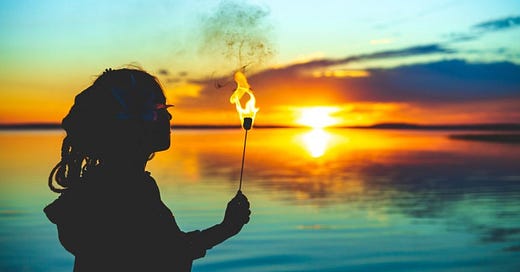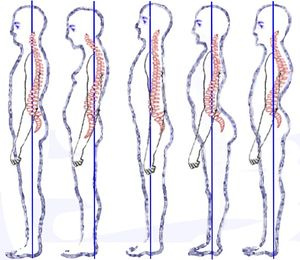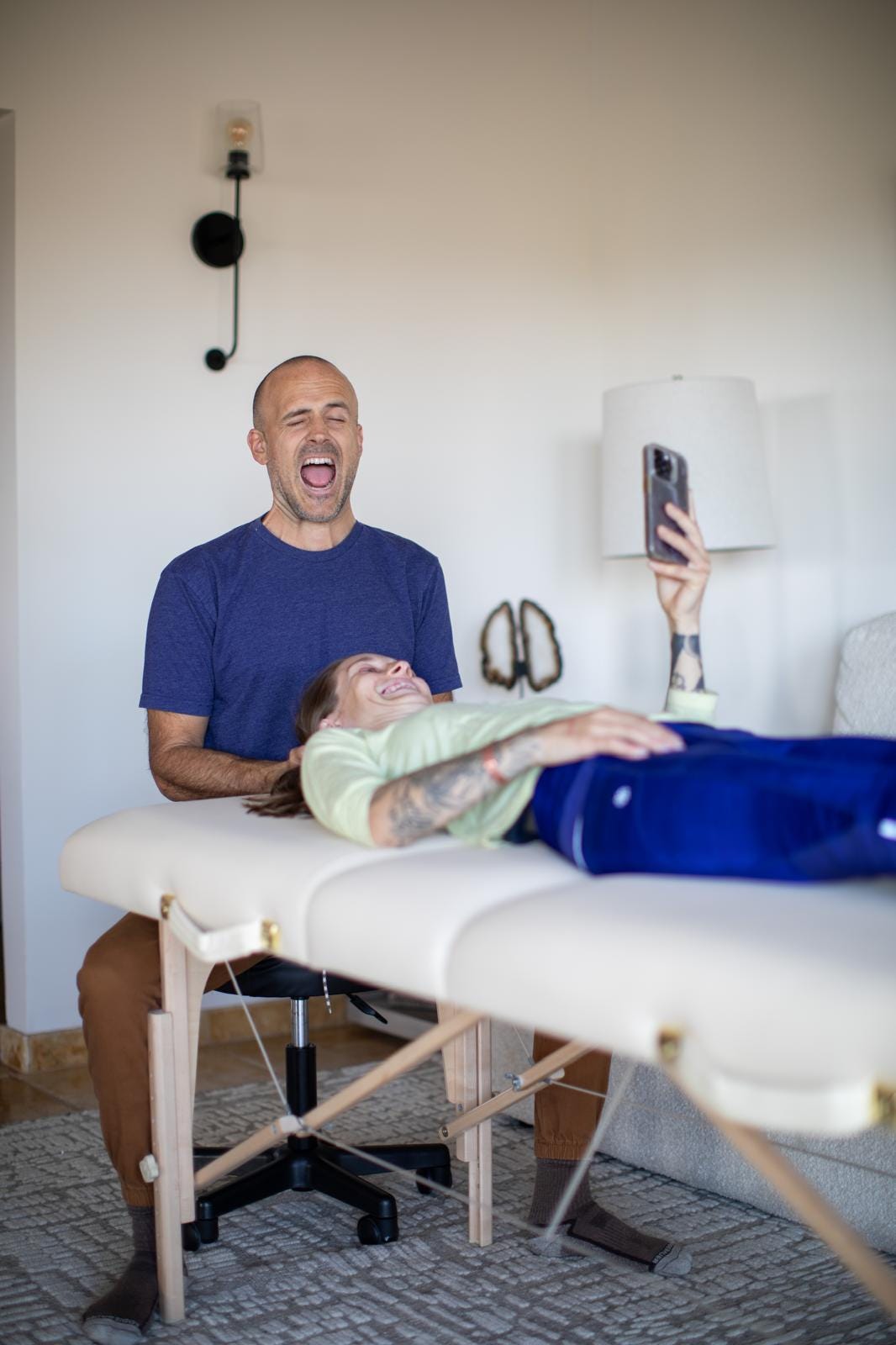Igniting Happiness in a Post-Truth World
Reclaiming the Embodied Wisdom of the Ildsjel: "Fire Soul"
Find the audio version by clicking the link above or the one below this section.
April Fool’s Day was earlier this month and it got me thinking about how tricky it’s becoming to know what’s true online. As I worked with this enquiry, I located the best fact checker inside my body and that was the inspiration for this essay…
This last month has been full of my own deep somatic work and developing and filming a new course. The days have me oscillating from eternal optimism knowing this is all theatre and taking life too seriously is the best way to get kicked off stage. And existential dread, fearing future suffering. The later comes much less frequently, but when it hits it hits like a Category 5 storm. A celebration I’ll share with you is about nervous system flexibility: those Cat 5’s used to take me down for days and even weeks. Now it’s more like seconds or minutes. For someone who’s been deep in many ditches, it’s satisfying and triumphant to notice these shifts. I’ve written a few essays over the last few weeks and they keep going long. This is the shortest one I could edit to fit in your email, so I hope you enjoy this piece about embodiment and adolescence.
Adolescence: A Time of Ignition
"Mysterious changes in the body. Hormonal flushes. Sudden, unbidden stirring's, softening's, and swellings. The longing to touch and be touched, and the terror of it too. Fire! The world fairly explodes for us with all this running about and erotic heat." — Bill Plotkin, wilderness guide and depth psychologist, on puberty.
While puberty is a biological stage we all pass through, adolescence is a psychological stage that can be left incomplete. Adolescence is a stage of leaning over the cliff for that sense of exhilaration, becoming wildly infatuated with a new crush, staying up late inquiring into the mysteries of the night, sprouting into life as a separate individual, unearthing what we are most passionate about, and peeking around corners at what we fear the most.
It's a time of exploration and experiment, trial and error, a time of chaos and liberation as we undergo the transformative novelty of stepping out into the wider arena of life. The spectacular entrance isn't without pitfalls of course. Adolescents must be discerning in this new house of mirrors, they must debate and challenge the clowns and kings they meet, they must seek with rigor the sources of the information they use to orient in this big new and unknown game they are stepping into. The price of stepping in is high and comes with both responsibility and risk.
Adolescent’s light the world on fire. The leap from this stage pulses through life, opening new possibilities full of imagination and sacral charge. The emotional storms and brilliance of this uniquely human stage of life must be honored, held in reverence and reclaimed by those who missed the tasks earlier in life. Since I’ve walked this path of reclamation, it’s quite rewarding to take responsibility in assisting adults reclaiming parts of themselves through the tasks of this stage, as a service to a more compassionate society.
What do you want more of in your life? And how might this be related to wholeness?
The Power of Cultural Myths
The stories we're told shape us both literally and figuratively. Our biology arranges itself according to our perception of the world. With proper training, one look at a person's posture, their eyes, and how they speak of life—it's easy to hypothesize about the stories they've internalized. A set of hunched over shoulders and caved in chest suggests a protected heart while a bulletproof chest might suggest the same. It's unique for each individual and our psychology is always reflected in our biology.
When we are unaware, without connection to our bodies, we like what's trending rather than liking what's authentic to us. In adolescence the pressure to fit in supersedes the process of practice that is deep communion with our selves—that intimate relationship with our internal landscape where we learn to listen to our body's wisdom. In an egocentric society, the priority is on status and fitting in. Many of us, directly or indirectly took on the message that our bodies are dirty; the inconvenience of menstrual blood, body hair, and feces. Yuck!
Consider this: when a mother-to-be is told she can follow a simple procedure after her baby is born that will restore lost nutrients, facilitate the transportation of antibodies to her baby through breastmilk, speed up her recovery, and improve her immune system—and it's free—she says, "Yes! Sign me up!" Yet when she's told to eat her baby's placenta she says, "No way, that's disgusting!"
Similarly, when a man struggling with debilitating chronic illness and gut health is told about a procedure that will vastly improve both his digestive and cognitive function, he's stoked until learning it's a fecal transplant. Then he says, “Nah, bro. That’s crazy.” These reactions reveal how deeply cultural myths about what is "acceptable" override what might actually benefit our bodies. Our bodies believe the stories we tell them and this directly impacts how we feel and how we heal.
The prevailing myths of culture limit our connection with reality. At the subtlest level we don't live in a material world of solid objects; there is a deeper truth, one that's not simply apparent, but ultimate. Most consider other cultures weird, funny, stupid or dangerous. We are biased against that which contradicts our stories. The beliefs or values we took on unconsciously in adolescence are so intertwined with who we take ourselves to be that when they are challenged, we become defensive. We've internalized cultural myths rather than discovering our own unique myths that we can trust at the deepest level—the level of our bodily wisdom.
What myths shaped your childhood? Your body? How have new myths shaped your adulthood?
Authentic Self in a Chaotic World
When chaos becomes pervasive, we often become scared, confused, lost, and easily taken advantage of by new myths. Myth's like, "those people are bad, and we are good," "you need to listen to us," or "it must feel good in order to be good for you." The last might be a myth the mother and man from the previous examples believe. Anyone who’s spent a night with their head buried in a bucket during a plant medicine ceremony knows it rarely feels good, and is often very good for you.
The task of becoming our authentic selves in social situations comes with risk. These risks are not to be avoided and are imperative for passage through the psychological bottleneck of this stage. Like a leaf dropping from a tree, in adolescence we break free from the self we created in our family of origin.
Individuation is a process of learning what is authentic to us, developing emotional literacy, learning how to confront and deal with conflict, understanding how to critically question authority, playing roles and being part of temporary hierarchical arrangements, knowing our sexual preferences, finding ways to provide for ourselves and learning what self-care is, coming into deeper connection with nature as a primary relationship, and the development of adaptive childhood survival strategies which we will have to untangle later in life, as adults.
Adolescence has it’s struggles and it also has it’s great fun. We seem to be stuck in a patho-adolescent society—one where many adults remain psychologically adolescent, never having completed the developmental tasks necessary for wholeness. We haven't completed these tasks and therefore we haven't developed the interiority to know what's really true for us.
"The Century of Self," a documentary series by Adam Curtis, highlights how Americans were manipulated by advertising once television became popular, showing how corporate interests shaped our desires. Similarly, "The Social Dilemma" showcases social media's powerful role in spinning societal myths and capturing our attention. For most of us, we like what culture likes rather than what's truly authentic to us. This leaves us vulnerable to being swayed by media because we don't have a solid center to return to. The root of the culture wars is buried in this soil. Our wholeness sprouts from embodied wisdom. The seeds were misplaced and disconnection from our bodies and the deep communion necessary to understand the language and messages of the body, misplaced.
If we haven't done the deep work to integrate our minds and bodies, it's difficult to know if we're being led by intuition or unresolved trauma. Like the example above, cultural stories shaped the expecting mother's perception, disconnecting her from her body and without even questioning where her reaction comes from, she rejects what's best for her while probably following unhealthy cultural trends. I don't know, I just made her up. Maybe she’s taken on an alternative ideology in reaction to society. Whether it's simply ignorance or a reaction—either way, it's inauthentic.
Truth in a Post-Truth Era
Now that the post-truth era has fully taken hold and lies are both told to trick us as well as not to be believed, but to see who's willing to turn a blind eye and play along—this is how power is concentrated in times like these. Deepfakes are becoming more difficult to differentiate from real videos. AI bots have already become creators of $300 million dollar market cap meme coins for being online religious figures. The world is bonkers and chaos is ramping up.
So, how do we spring more truth, happiness and aliveness into the world during these deeply chaotic and dark times? From a biological standpoint, both truth and happiness arise from the same place—our interoceptive awareness, our ability to notice the sensations of our internal bodily states. Our bodyminds (the inseparable connection between body: physical sensation, and mind: consciousness) house the wisdom of both truth and happiness, and once we are deeply acquainted with all the nooks and crannies of this house, they become the most reliable fact-checkers and ecstatic partners we will ever have.
The Body as Truth-Teller
Our sense perceptions inform our preferences, pointing toward the foundation from which both truth and happiness arise. The emotions we experience can easily be adaptive and therefore inauthentic or strategic, so we must look deeper. Our authentic preferences arise from within yet the emotional signals can be muffled. The source of truth and the source of happiness emerge from the same internal place— our sensations. The authentic sensations that arise within our bodies inform our unique feelings.
Our aesthetics then inform our true feelings which become our preferences which then may lead us to happiness. Since the world is not as it seems—no time, no space, the mental constructs we create are a result of our “aesthetics”, a word lost in translation from Greek to German to English. Aesthetics can be thought of then as how we relate to our sense perceptions. True values are also clearly aesthetic in nature—arising from within. Meaning both truth and happiness arise from the same place—our sense perceptions. Our bodies inform our minds of what is right for us and what we like. The truth lives in direct experience and no experience is more direct than our sensations.
What can be truer than the sensations in our bodies?
A teacher of mine, Goenkaji, taught that truth can only be fully understood through direct experience, not intellectual reasoning or faith alone. By observing bodily sensations, we can penetrate surface-level realities to uncover deeper truths. Observing them with equanimity—without craving or aversion—helps us break habitual mental reactions, which are the root cause of suffering. It’s as simple as noticing the breath and sensations.
Bodily sensations mirror the mind's reactivity to the external world or internal thoughts. By observing sensations, we can access the unconscious mind, dissolve deep-seated mental conditioning, and free ourselves from reactive patterns. Making a practice of observing sensations, we can reach deeper levels of awareness where we experience ultimate truths about existence and become much needed “embodied myth-busters.”
Goenka emphasized the universality of this approach, stating that sensations are a tangible tool accessible to everyone regardless of belief systems. Observing sensations is a gateway to wholeness and understanding our own nature. We may achieve inner peace, have more capacity to discern what’s true, know what makes us happy, and have the energy and agency to take risks.
Becoming a Fire Soul
To be a "fire soul" or ildsjel—passionate agents of change who ignite others with their authentic presence—discerning truth and finding happiness are vital and essential for embodying our truest expression in the world. And we can't know these things without a deep relationship with our bodies.
The path of becoming this kind of change-maker begins with reuniting with our bodily wisdom and developing that interoceptive awareness that connects us to what is genuinely true for us. In a world increasingly dominated by manufactured realities, our bodies remain our most reliable guides—if only we slow down and learn to listen.
~*~
I'm excited to expand my practice to helping others reestablish this crucial connection of nervous system flexibility through somatic practices like noticing, breathwork, and touch. These embodiment practices have been my personal pathway from the dark muddy roadside ditch of chronic illness toward authentically inhabiting my body in a way I haven’t since adolescence. If you or someone you know has hit rock bottom recently—whether through chronic illness, addiction, burnout, or anxiety— my years of training in somatic trauma healing and trauma psychoeducation along with overcoming all of the above in my own life, have equipped me with tools that can help. A new course on nervous system flexibility is coming soon. Reach out for more information on how embodiment and the wisdom of the body can guide your journey toward truth and happiness.
Roar,
Patrick








